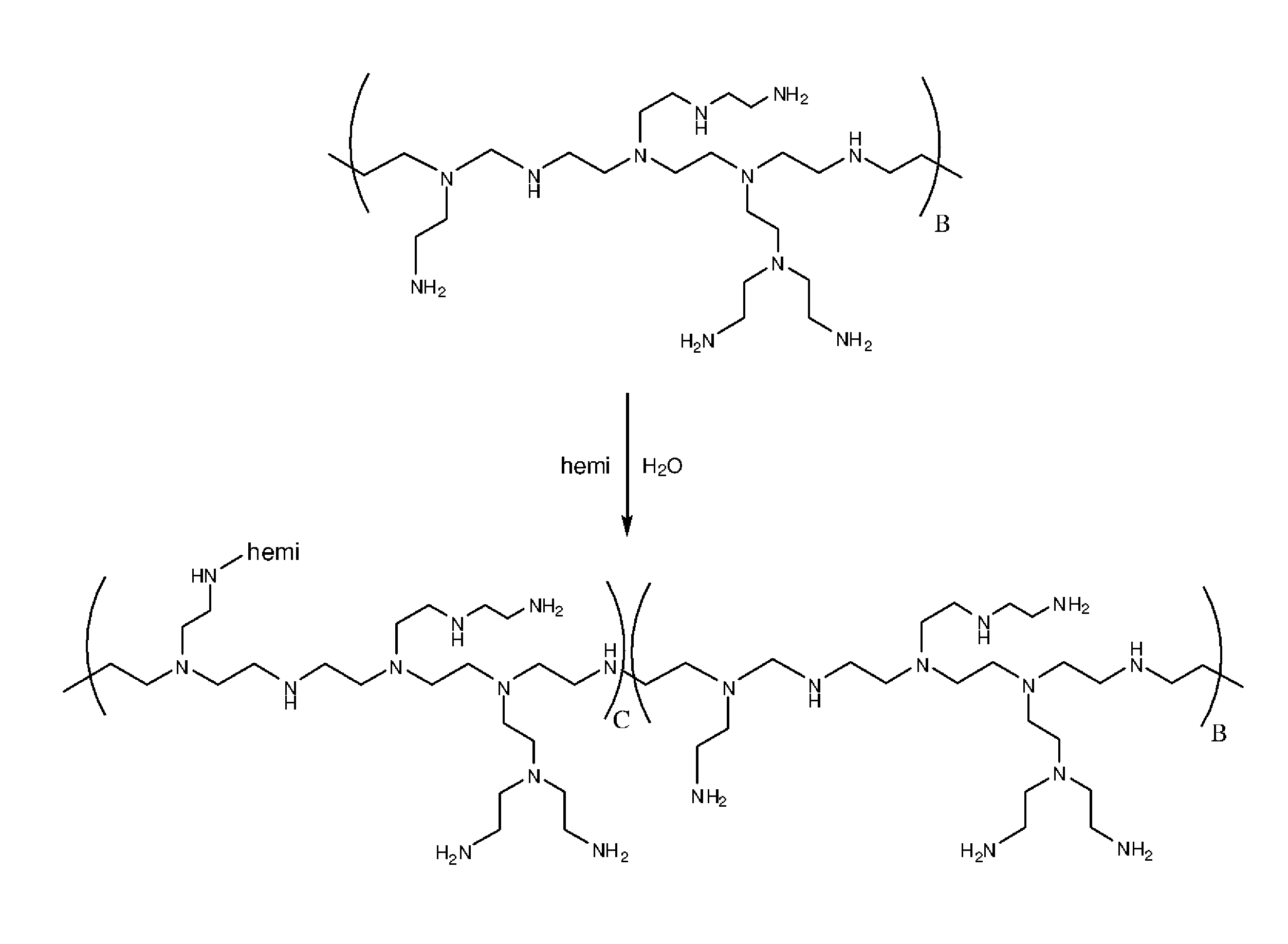Polymer made of a primary amine functionalized polymer and a hemicellulose
- Summary
- Abstract
- Description
- Claims
- Application Information
AI Technical Summary
Benefits of technology
Problems solved by technology
Method used
Image
Examples
example 1
[0170]Chitosan (Mw 50 kDa-190 kDa) (1 g, 0.0067 mmol) and xyloglucan (Mw ˜15,000 Da) (2.6 g, 0.17 mmol) were dissolved in a mixture of 25 mL methanol and 25 mL water with 1% acetic acid. The pH was about 4-5. Additional 50 ml of water was added to get a clear solution, followed by addition of sodium cyanoborohydride (109 mg, 1.73 mmol). The reaction was stirred at 55° C. overnight. The reaction mixture was cooled to room temperature followed by precipitation in 1 L of ethanol (95%). The precipitate was collected and redissolved in water and the ethanol residues were removed by evaporation. The resulting solution was freeze dried to yield a white solid of 3.35 g (93%).
example 2
[0171]Hand sheets (60 g / cm2) were made of unrefined pine pulp adsorbed with 2% of the product from example 1. 2% XG (15000) was used as a comparative example and a sheet without additives was used as a control. The hand sheets were made according too ISO 5269-2.The sheets were tested for tensile index and folding endurance strength, see FIGS. 2a and 2b. The folding endurance was tested according to IS05626, the grammage was tested according to ISO 534, and tensile strength was tested according to ISO 1924-3:2005.
[0172]The test results are shown in FIGS. 2a and 2b.
[0173]The test results show that the addition of the material made of chitosan and xyloglucan (product prepared according to example 1) results in a paper which has a slightly increased tensile strength and which surprisingly has a folding endurance that is five to six times the folding endurance of the control sheet.
example 3
A General Procedure for the Synthesis of Polymer Made From xyloglucan-chitosan
[0174]Chitosan (Mw 5000 Da,150 000 Da, 250 000 Da, or 340 000 Da) was dissolved in water with 1-2% acetic acid. The amount of xyloglucan added depends of the desired substitution degree e.g. 1 g of chitosan with MW of 250 000 Da (0,004 mmol) has 1090 free amino groups if the desired substitution degree of xyloglucan with MW 15 000 Da is 5% then ˜55 equivalents (3.3 g; 0.22 mmol) of xyloglucan should be added. When the xyloglucan was dissolved the NaCNBH3 was added e.g. for 55 equivalents of xyloglucan (3.3 g; 0.22 mmol) 55 equivalents (14 mg; 0.22 mmol) of NaCNBH3 was added, and the reaction was stirred at 55° C. The reaction was monitored using a DMSO SEC (Size Exclusion Chromatography), monitoring the disappearance of the xyloglucan peak. Every 24 hours the reaction was running new addition of the same amount of NaCNBH3 was added to the reaction. The reaction mixture was cooled to room temperature follow...
PUM
| Property | Measurement | Unit |
|---|---|---|
| Mass | aaaaa | aaaaa |
| Mass | aaaaa | aaaaa |
| Atomic weight | aaaaa | aaaaa |
Abstract
Description
Claims
Application Information
 Login to View More
Login to View More - R&D
- Intellectual Property
- Life Sciences
- Materials
- Tech Scout
- Unparalleled Data Quality
- Higher Quality Content
- 60% Fewer Hallucinations
Browse by: Latest US Patents, China's latest patents, Technical Efficacy Thesaurus, Application Domain, Technology Topic, Popular Technical Reports.
© 2025 PatSnap. All rights reserved.Legal|Privacy policy|Modern Slavery Act Transparency Statement|Sitemap|About US| Contact US: help@patsnap.com



